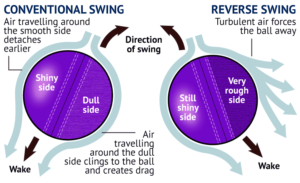
The basic idea of swing bowling is to sway the cricket ball as it moves towards the batsman. The most important factors to achieve this are:
- The amount of wear and tear
- The speed of bowling
- The grip of the bowlers
A swing bowler generally uses three swings: conventional, reverse and contrast swing.
Let’s have a glimpse into them one by one:
Conventional Swing Ball
- The new cricket ball is needed to swing best before it experience of any wear and tear. It should have a high quality seam, with one shiny side.
- The bowler needs to hold the ball along the seam.Hold it with your middle and index fingers on the other side of the seam, with the ball resting on your thumb and third finger. The shiny side should face in the direction of the batsman.
- Now let loose the ball with the seam pointing to the direction of the inswing ball sways from the leg side toward the off side. The outswing ball sways from the leg side is an outswing.
A conventional swing works best between 30 and 70 mph.

Reverse Swing Ball
- A ball that is used at least 40 overs is helpful. A new ball swings naturally in a conventional direction, but at about this time, the ball that wears on adjusts its aerodynamics. It starts on swinging in the opposite direction of seam, towards the shine.
- Keep the ball in good form.With the smooth side of the ball it becomes very smoother and rough side becomes rougher, the reverse swinging ball works well. You need to shine the smooth sides of the ball.
- Polish the smooth side of the ball throughout the play. Keep in mind, however, the rub the rough side constitutes tampering, and is unlawful.
Contrast Swing Ball
Practice is the solution. Focus mostly on the line and length for a long time.

